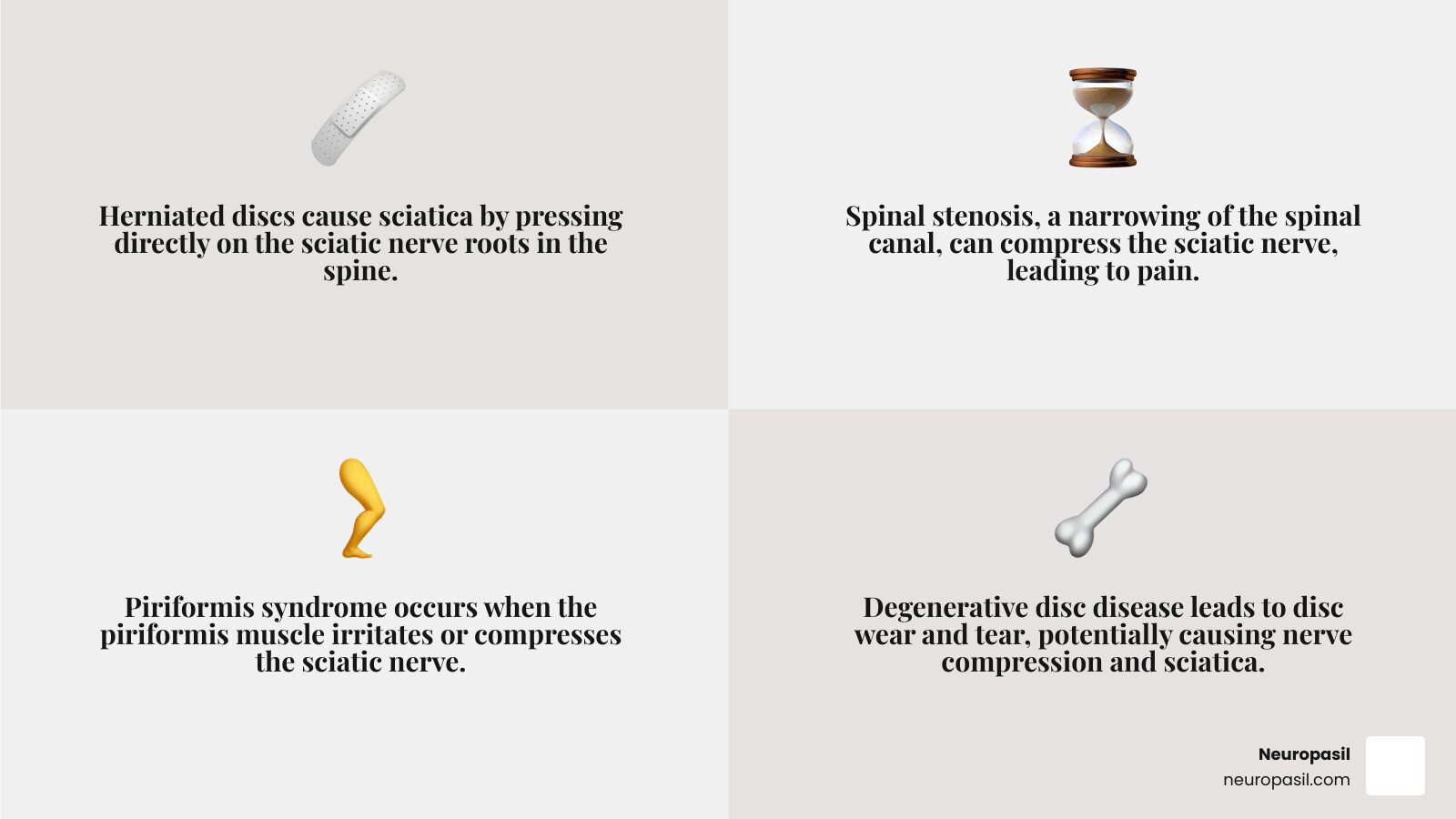Why Sciatica Medication Matters for Your Pain Relief
Medication for sciatica can be the difference between debilitating pain and returning to your active lifestyle. If you're dealing with shooting pain down your leg, you're not alone—about 40% of people experience sciatica in their lifetime.
Quick Answer: Common Sciatica Medications
Over-the-Counter Options:
- NSAIDs (ibuprofen, naproxen) - reduce inflammation and pain
- Acetaminophen - pain relief without anti-inflammatory effects
- Topical creams - localized relief with menthol or capsaicin
Prescription Options:
- Muscle relaxants - for muscle spasms (cyclobenzaprine, baclofen)
- Nerve pain medications - gabapentin, pregabalin for neuropathic pain
- Antidepressants - amitriptyline, duloxetine for chronic nerve pain
- Corticosteroids - oral or injected for severe inflammation
Note: Research shows pregabalin is no more effective than placebo for sciatica, despite being commonly prescribed.
Sciatica occurs when the sciatic nerve becomes compressed or irritated, causing pain that radiates from the lower back down the leg, sometimes to the foot. The pain can feel like a sharp shock, a burning sensation, or a constant ache, and may be accompanied by numbness, tingling, or muscle weakness.
While most cases resolve within 4-6 weeks, the right medication can help you manage pain and stay active during recovery. Understanding which medications work best for your specific pain is key.

Understanding First-Line Relief for Sciatica
When sciatica strikes, the initial goal is to manage immediate discomfort and inflammation. Acute pain often stems from direct nerve compression and swelling, making inflammation a key target in the early stages.
Self-care measures are the first line of defense. Applying ice to the affected area for 15-20 minutes at a time can reduce swelling, while a heating pad can relax tight muscles and increase blood flow. Many people find alternating between hot and cold packs effective.
Over-the-Counter Approaches for Sciatica: What’s Commonly Used?
For mild to moderate pain, over-the-counter (OTC) medication for sciatica can be effective for short-term relief.
- Nonsteroidal Anti-Inflammatory Drugs (NSAIDs): Medications like ibuprofen (Advil, Motrin IB) and naproxen sodium (Aleve) work by reducing inflammation, a common cause of sciatic pain. They are a good starting point for many but should be used short-term to avoid potential stomach, ulcer, or kidney issues.
- Acetaminophen: Commonly known as Tylenol, this medication relieves pain but does not have significant anti-inflammatory effects. It's an alternative if NSAIDs are not suitable for you.
Topical pain relievers, such as creams or patches with menthol or capsaicin, can also offer localized relief with fewer systemic side effects. Always follow dosage instructions, as overdosing on any medication can be harmful. If you have pre-existing health conditions or take other medications, consult your healthcare provider before starting any new medication for sciatica.
Home Remedies and Lifestyle Adjustments
Simple changes can significantly reduce discomfort and promote healing. Combining these with appropriate medication creates a strong foundation for recovery.
- Gentle Stretching: Staying active with gentle stretches for the lower back, hips, and hamstrings can relieve pressure on the sciatic nerve. Hold each stretch for at least 30 seconds without bouncing.
- Avoid Prolonged Sitting: Sitting increases pressure on the lower back. Get up and move every 20-30 minutes, and consider a standing desk.
- Maintain Proper Posture: Good posture aligns your spine and reduces strain. When sitting, keep your feet flat on the floor with your back supported. For more tips, see this guide on good posture.
- Activity Modification: Be mindful of movements that aggravate your pain, such as rapid twisting or heavy lifting. When lifting, bend your knees and use your leg muscles.
- Improve Sleep Support: A firm mattress provides better spinal support. Try placing a pillow under your knees when on your back or between your knees when on your side to maintain a neutral spine.
Neuropasil: A Targeted Approach for Sciatica Relief
When self-care and general pain relievers aren't enough, especially for moderate to severe pain with neuropathic qualities (burning, tingling, or electric shocks), it's time for a more targeted solution. If your Sciatic Nerve Pain persists, a conversation with your doctor can help you find a more effective approach.
This is where Neuropasil can help. We focus on creating a supportive option that specifically addresses nerve health, rather than just masking symptoms.
Here's how different approaches stack up for sciatica relief:
| Approach | What It Involves | Best For |
|---|---|---|
| Self-care | Ice/heat therapy, gentle stretches, basic pain relievers | Mild pain, early stages, supporting other treatments |
| Neuropasil | Targeted nerve support, addressing discomfort at its source | Moderate to severe pain, nerve-related symptoms, when basic approaches fall short |
| Lifestyle Changes | Better posture, movement breaks, ergonomic improvements | Essential for everyone - prevention and long-term success |
How Neuropasil Supports Sciatic Nerve Health
Neuropasil's approach differs from typical pain relievers by supporting healthy nerve function. Our formula contains key ingredients chosen for their role in nerve health, working to support your body's natural healing processes.
Neuropasil works by targeting the root of nerve discomfort. Nerve pain is different from other types of pain, as it involves a hypersensitive nervous system. Traditional pain medications can miss this distinction. By supporting healthy nerve function and addressing discomfort at the source, Neuropasil aims to help restore balance to your nervous system. We've also prioritized a safety profile that allows most people to consider it for their daily wellness routine.
When to consider Neuropasil is typically after basic self-care has proven insufficient, especially if you have telltale nerve symptoms. It's worth discussing with your healthcare provider if OTC options aren't providing the relief you need.
Combining Neuropasil with Lifestyle Changes
A multi-strategy approach is often most effective. Combining Neuropasil's targeted nerve support with smart lifestyle changes addresses the problem from multiple angles.
Muscle spasms often accompany sciatica. While Neuropasil works on the nerve component, gentle movement and stretching help break the pain-spasm cycle. The importance of gentle movement cannot be overstated; it maintains flexibility and strengthens supporting muscles. Your strategy should include both short-term (walking breaks) and long-term (regular exercise, healthy weight) elements.
Neuropasil is designed for ongoing nerve health support and is not for acute emergencies. If you develop severe weakness, numbness, or loss of bladder control, seek immediate medical attention.
Before starting Neuropasil, we strongly encourage discussing with your healthcare provider. They can determine if Neuropasil fits into your overall treatment plan.
A Deeper Look: Neuropasil and Comprehensive Sciatica Care
When over-the-counter options and basic self-care aren't enough, it's time for comprehensive sciatica care. This is especially true if your pain has a neuropathic quality—burning, tingling, or electric-shock sensations—indicating the sciatic nerve itself needs targeted support.

Persistent symptoms are a sign that a different approach is needed. Specialized nerve support can work alongside lifestyle changes to address the root cause of discomfort.
The Evidence on Neuropasil for Sciatica
Interestingly, a common prescription for nerve pain, pregabalin, was shown to be no more effective than a placebo for sciatica in the PRECISE trial, and it came with more side effects. This highlights the need for better approaches to neuropathic pain theory and treatment.
Nerve pain is fundamentally different from other pain types. When the sciatic nerve is compressed, the nerve cells can become hypersensitive and send faulty pain signals. Research on nerve health ingredients shows promise in supporting the body's natural repair processes. Unlike traditional medication for sciatica that may just mask symptoms, targeted nutritional support aims to give your nerves what they need to function optimally. You can learn more on our page about Research on nerve health ingredients.
User experiences with Neuropasil often report gradual improvement with consistent use. Its safety and tolerability profile is favorable for long-term management.
When to Seek Further Medical Evaluation
Knowing the red flag symptoms for sciatica is crucial. While most cases improve with conservative care, some signs require immediate attention.
When to see a doctor: If your pain persists for more than a few weeks despite self-care, or if it worsens and interferes with daily activities, it's time for a professional evaluation. A doctor can run tests to diagnose the cause of your Sciatica Pain.
Immediate emergency care is needed for: sudden, severe leg weakness, numbness in your groin or saddle area, or loss of bladder or bowel control. These could signal cauda equina syndrome, a rare but serious condition requiring urgent treatment to prevent permanent damage.
Surgery as a last resort is typically considered only after six months of failed conservative treatment or for serious neurological symptoms. Procedures like diskectomy or laminectomy aim to relieve pressure on the nerve. Fortunately, most people with sciatica do not require surgery.
Beyond Pills: A Holistic Path to Sciatica Recovery
While medication for sciatica provides crucial pain relief, it's often just one piece of the puzzle. A holistic approach addresses root causes, strengthens your body, and helps prevent future flare-ups, empowering you to take an active role in your healing.

This comprehensive strategy focuses on long-term management and preventing recurrence, moving beyond symptom management to build resilience.
The Critical Role of Physical Therapy
Physical therapy can transform your sciatica recovery by re-educating your body's mechanics. A therapist will create a personalized plan to address your specific weaknesses and movement patterns.
Key components of physical therapy include:
- Strengthening core muscles: A strong core acts as a natural back brace, taking pressure off your spine.
- Improving flexibility: Stretching tight hamstrings, hip flexors, and the piriformis muscle can provide significant relief.
- Nerve gliding exercises: These gentle movements help the sciatic nerve slide more freely, reducing irritation.
- Posture correction: Learning proper body mechanics for daily activities is key to prevention. The McKenzie method is a specific technique that can help centralize and eliminate pain.
Research confirms that staying active with structured exercise is beneficial. As noted in this study on Advice to Stay Active or Structured Exercise, movement is medicine. Finding a qualified therapist specializing in spinal conditions is essential for safe and effective progress.
Alternative Therapies: What Does the Evidence Say?
Many people explore alternative therapies alongside conventional treatment. Always discuss these with your doctor first.
- Acupuncture: Involves inserting thin needles to stimulate the body's pain-relief systems. Evidence is still developing, but many find it helpful.
- Massage therapy: Can relax tight muscles in the lower back, buttocks, and legs that may be contributing to nerve pressure.
- Biofeedback: Teaches you to consciously control functions like muscle tension, which can help manage pain responses.
Manage expectations with these therapies, as they work best as complements to, not replacements for, professional medical care. When considering a provider, ask about their training, experience with sciatica, and how their therapy will integrate with your current medical plan.
Frequently Asked Questions about Sciatica Approaches
Here are answers to common questions about managing sciatica.
How long does it take for sciatica approaches to work?
Timelines vary depending on the treatment and the individual. Most people see improvement within 4-6 weeks with consistent care.
- Self-care (ice/heat): Can provide immediate, though often temporary, relief within hours.
- Lifestyle changes: Begin protecting your nerve immediately, with noticeable pain relief often taking a few weeks.
- Neuropasil: As a nerve support supplement, it works gradually. Some notice subtle changes within a week, but consistent use over several weeks typically yields the most benefit.
- Prescription medications: Muscle relaxants may work in a day or two, while nerve pain medications can take a few weeks to reach full effect.
- Physical therapy: You may feel more mobile after a few sessions, but building preventative strength takes weeks or months.
Your doctor can provide a personalized timeline.
Can I combine different approaches for sciatica?
Yes, a combined approach is often the most effective strategy. However, you must always consult your doctor first, especially when medications are involved. A comprehensive plan might include OTC relievers, physical therapy, lifestyle changes, and a nerve support supplement like Neuropasil.
It is crucial to disclose everything you are taking to your healthcare provider—all medications, supplements (including Neuropasil), and alternative therapies. This transparency prevents harmful interactions and ensures your treatments are complementary.
What are the red flag symptoms I should watch for?
While most sciatica is not an emergency, certain symptoms require immediate medical attention. Go to the emergency room if you experience any of the following:
- Sudden, severe leg weakness or inability to lift your foot (foot drop).
- Numbness in your groin or "saddle" area (the parts that would touch a saddle).
- Loss of bladder or bowel control (incontinence or retention).
- Fever accompanied by back pain, especially with chills.
These rare symptoms can indicate serious conditions like cauda equina syndrome, which requires urgent treatment to prevent permanent damage.
Taking Control of Your Sciatica Treatment
Living with sciatica doesn't mean the pain is in control. By becoming an active participant in your treatment, you can significantly influence your recovery.
Preparing for your doctor's appointment is a powerful first step. The more information you provide, the better your doctor can help.
- Track your symptoms: Keep a simple diary of what your pain feels like, when it occurs, and what makes it better or worse. Note how it affects your daily activities and sleep. This helps your doctor understand your specific Sciatica Symptoms.
- Prepare questions: Write down questions beforehand. Ask about the cause of your sciatica, your options for medication for sciatica, the expected recovery time, and any warning signs to watch for.
- List all medications and supplements: Include everything you take, from prescriptions to vitamins. Mentioning Neuropasil is important if you are considering or already using it.
A comprehensive treatment plan aims for long-term nerve health and function, not just immediate pain relief. This often involves combining approaches: medication for acute pain, physical therapy for strength, lifestyle changes for prevention, and nerve support supplements for long-term health.
Partnering with your healthcare provider is key. You are the expert on your body, and they are the expert on treatment options. Through honest, two-way communication, you can steer your choices together.
Recovery takes time and patience. Stay engaged, ask questions, and speak up if a treatment isn't working. For those taking a proactive approach, Neuropasil offers targeted support for your nerve health. You can Find lasting nerve pain relief with Neuropasil and take an important step toward managing your sciatica more effectively.
Your journey is unique, but you don't have to do it alone. With the right preparation and a collaborative treatment plan, you can work toward a better quality of life.














